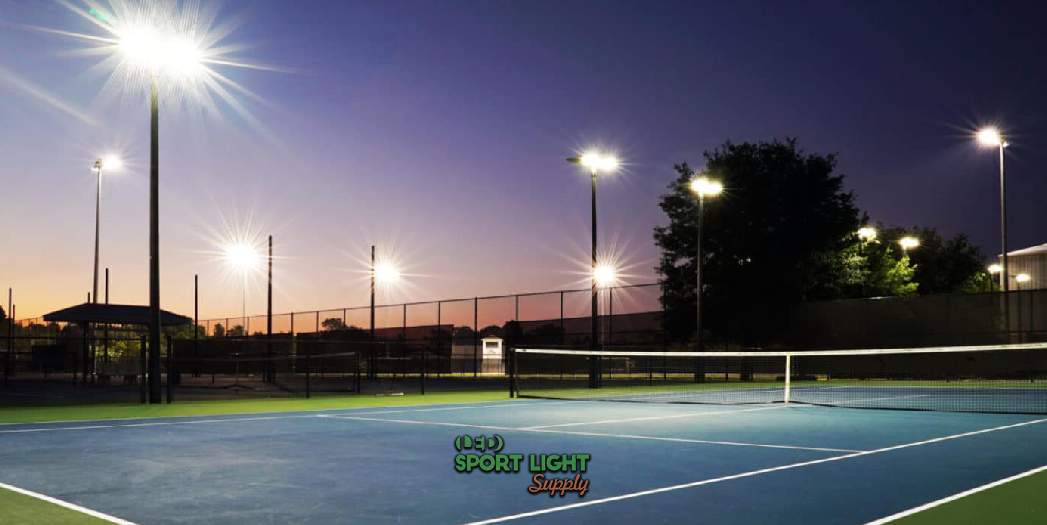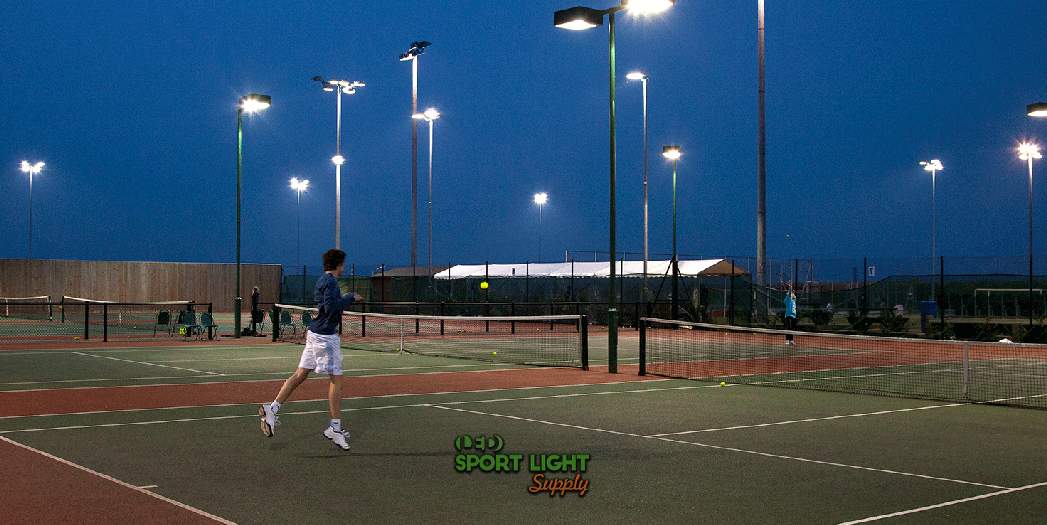Tennis is a sport that requires precision, agility, and exceptional hand-eye coordination. To perform at their best, players need optimal lighting conditions that minimize shadows and glare while ensuring the entire court is uniformly lit. Tennis court lighting is a crucial aspect of any facility, whether it’s a local community court, a professional tournament venue, or a private residence.
Inadequate or poorly designed lighting can cause uneven illumination, leading to shadows and glare that interfere with players’ ability to see the ball and judge its speed and trajectory. Moreover, insufficient lighting can increase the risk of injuries due to missteps or collisions. Hence, investing in high-quality lighting is vital for any tennis facility aiming to provide a safe and enjoyable playing experience.

Table of Contents
ToggleTo ensure optimal playing conditions, tennis court lighting must meet specific standards and requirements. The International Tennis Federation (ITF) and other sports governing bodies have established guidelines for lighting levels, uniformity, and color temperature.
The amount of light needed for a tennis court depends on the level of play and the location of the court. For recreational play, a minimum of 300 lux (a measure of illuminance) is generally sufficient. However, for professional tournaments and televised matches, lighting levels should be significantly higher, typically around 500-1000 lux. Indoor courts also require higher lighting levels compared to outdoor courts to compensate for the absence of natural light.
Uniformity is crucial in tennis court lighting to ensure consistent visibility across the entire playing surface. Poor uniformity can create bright and dark spots, making it difficult for players to track the ball. The uniformity ratio, which compares the minimum and average lighting levels, should ideally be no less than 0.7. Achieving high uniformity involves careful planning of the number and placement of light fixtures.
The color temperature of lighting, measured in Kelvin (K), affects the visual comfort and perception of colors. For tennis courts, a color temperature of 4000K to 6000K is recommended, providing a bright, white light that closely resembles daylight. This range enhances players’ ability to see the ball clearly and accurately perceive its movement.

Designing an effective lighting system for tennis courts involves several key considerations, including the type and placement of light fixtures, minimizing glare, and accounting for environmental factors.
LED floodlights are the most common choice for tennis court lighting due to their high efficiency and excellent light distribution. These fixtures should be strategically placed to ensure even coverage of the entire court. Typically, lights are mounted on poles at the corners and sides of the court, with the height and angle adjusted to minimize shadows and provide uniform illumination. For standard-sized tennis courts, poles are usually placed at a height of 6 to 8 meters.
Glare can be a significant issue in tennis court lighting, especially for players looking up to serve or return high balls. To minimize glare, it is essential to use fixtures with proper shielding and opt for LED lights with a low Unified Glare Rating (UGR). Additionally, the positioning of lights should be carefully planned to avoid direct lines of sight between players and the light sources.
Outdoor tennis courts are exposed to various environmental factors such as wind, rain, and temperature fluctuations. Therefore, lighting fixtures must be weather-resistant and robust enough to withstand harsh conditions. IP65-rated LED lights, which are dust-tight and protected against water jets, are ideal for outdoor tennis court lighting. Furthermore, considerations should be made for light pollution and its impact on surrounding areas. Using directional fixtures and shields can help control light spillage and ensure that the lighting is focused solely on the court.
Indoor tennis courts require different considerations compared to outdoor courts. Since indoor environments can be controlled, factors such as weather resistance are less critical. However, the design should ensure that lighting is evenly distributed without creating reflections or glare from walls or ceilings. Additionally, indoor facilities can benefit from advanced lighting controls that allow for the adjustment of lighting levels based on usage and events.
The shift towards LED lighting for tennis courts offers numerous benefits beyond energy efficiency and improved performance. These advantages make LEDs the preferred choice for modern tennis facilities.
LEDs consume significantly less power than traditional lighting systems, leading to substantial energy savings. This reduction in energy consumption not only lowers operational costs but also contributes to environmental sustainability. Although the initial investment in LED lighting may be higher, the long-term savings on electricity bills and maintenance costs make it a cost-effective solution.
LED lights have a much longer lifespan compared to conventional lamps, often lasting up to 120,000 hours or more. This durability translates to reduced maintenance needs and fewer replacements, ensuring that the tennis court remains well-lit with minimal interruptions. LEDs are also more resistant to shock and vibration, making them suitable for outdoor installations where they may be exposed to various physical stresses.
LEDs provide superior light quality with high color rendering index (CRI) values, ensuring that colors appear more vivid and true to life. This feature is particularly important for tennis, where players need to accurately perceive the ball’s color and movement. The even distribution of light and reduced glare offered by LED fixtures enhance visual comfort for both players and spectators.
LED lighting is an environmentally friendly option due to its low energy consumption and the absence of harmful substances such as mercury. The reduction in energy use helps decrease carbon emissions, contributing to a greener planet. Additionally, the long lifespan of LEDs means fewer replacements and less waste, further reducing their environmental impact.
To maximize the benefits of LED lighting for tennis courts, proper installation and maintenance practices must be followed. This ensures that the lighting system operates efficiently and provides optimal performance throughout its lifespan.
Hiring experienced professionals to design and install the lighting system is crucial for achieving the desired results. Professionals can conduct a thorough assessment of the site, considering factors such as court dimensions, surrounding structures, and environmental conditions. They can also recommend the best fixtures and configurations to meet specific requirements.
Although LED lights require less maintenance than traditional lighting systems, regular inspections and cleaning are still necessary to ensure optimal performance. Dirt and debris can accumulate on fixtures, reducing their effectiveness and causing uneven lighting. Periodic checks should also be conducted to identify any damaged or malfunctioning components that need replacement.
For facilities with outdated lighting systems, upgrading to LED technology can bring significant improvements. Retrofitting existing fixtures with LED equivalents is a cost-effective way to enhance lighting quality and reduce energy consumption. Professional consultation can help determine the best approach for upgrading and integrating new LED lights into the existing infrastructure.
The cost of installing and maintaining tennis court lighting is a significant consideration for facility owners, whether for a public park, private club, or professional venue. While the initial investment can be substantial, the long-term benefits, particularly with LED lighting, often outweigh the upfront costs. This section delves into the various cost factors associated with tennis court lighting and highlights how LED technology offers a cost-effective and sustainable solution.
The initial investment in tennis court lighting encompasses several components, including the cost of fixtures, installation, and any necessary infrastructure upgrades. LED lighting fixtures, although more expensive upfront compared to traditional lighting systems like metal halide or high-pressure sodium lamps, offer numerous advantages that justify their cost.
LED fixtures typically cost more than traditional lighting options due to their advanced technology and longer lifespan. However, prices for LED lights have been steadily decreasing as the technology becomes more widespread and manufacturing processes improve. The cost of LED fixtures can vary based on their specifications, such as wattage, lumen output, and additional features like dimming capabilities or smart controls.
Installation costs can vary significantly depending on the type of court (indoor or outdoor), the complexity of the lighting design, and local labor rates. Outdoor courts may require more substantial infrastructure, such as poles and weatherproof fixtures, which can increase costs. Conversely, indoor courts might have higher costs related to integrating the lighting with existing structures and ensuring proper heat dissipation.
Upgrading to LED lighting may require modifications to the existing electrical infrastructure to support the new system’s power requirements. While LEDs consume less power overall, ensuring that wiring and control systems are compatible with the new technology is essential. These upgrades can add to the initial costs but are a crucial part of the investment.
One of the significant advantages of LED lighting is its lower operational and maintenance costs compared to traditional lighting systems. This aspect can lead to substantial savings over time, offsetting the higher initial investment.
LED lights are highly energy-efficient, consuming significantly less electricity than traditional lighting options. This efficiency translates to lower energy bills, especially for facilities with extensive operating hours. For example, an LED system might consume 50% to 70% less energy than a comparable metal halide system, resulting in significant cost savings.
LED fixtures have a much longer lifespan than traditional lamps, often lasting 120,000 hours or more. This longevity reduces the frequency of replacements and the associated labor costs. Traditional lamps, such as metal halide, typically need replacement every 10,000 to 15,000 hours, leading to higher maintenance costs over time. Additionally, LED fixtures are more robust and resistant to shock and vibration, further reducing maintenance needs.
Less frequent maintenance means reduced downtime for the tennis court, ensuring that the facility remains operational and generating revenue. This efficiency is particularly crucial for commercial venues that rely on continuous operation to maximize their return on investment.
While the initial investment in LED lighting may be higher, the long-term financial benefits are substantial. These benefits include reduced energy costs, lower maintenance expenses, and increased operational efficiency. Additionally, many regions offer incentives and rebates for upgrading to energy-efficient lighting systems, further offsetting the initial costs.
The return on investment for LED lighting can be realized relatively quickly, often within a few years. The exact payback period depends on factors such as the facility’s operating hours, energy rates, and maintenance costs. Once the initial investment is recouped, the ongoing savings contribute directly to the facility’s bottom line, making LED lighting a financially sound choice.
Beyond the direct financial benefits, investing in LED lighting also supports environmental sustainability. Reduced energy consumption lowers the facility’s carbon footprint, contributing to broader efforts to combat climate change. Additionally, the long lifespan of LED fixtures means less waste, as fewer lamps need to be disposed of over time. This environmental consideration can also enhance the facility’s reputation and appeal to eco-conscious users.
Proper lighting is essential for maintaining a high standard of play on tennis courts, ensuring visibility, safety, and an optimal playing experience. By adhering to established standards for lighting levels, uniformity, and color temperature, and by investing in high-quality LED fixtures, facilities can enhance the performance and safety of their courts. Despite the higher initial investment, the long-term benefits of LED lighting—including energy efficiency, durability, and reduced maintenance costs—make it a wise choice for modern tennis venues. Ultimately, well-designed lighting not only improves gameplay but also contributes to a more enjoyable and sustainable sporting environment.
Drop us a line to receive a free lighting design